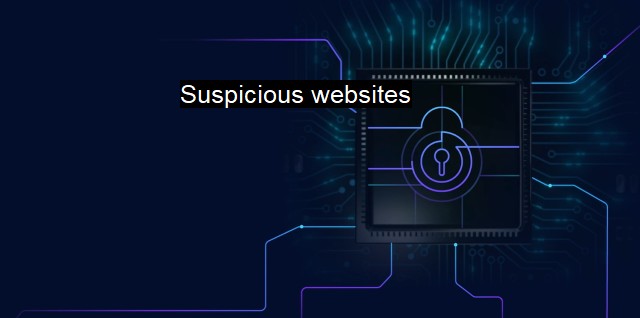What are Suspicious websites?
The Online Dangers You Should Know: Unveiling the Threat of Suspicious Websites and How to Stay Protected in Cyberspace
Suspicious websites are online platforms or domains that display irregular behavior, elements of deceit, or carry traits that raise concern or doubtAbout their authenticity or safety in the broader context of cybersecurity and antivirus concepts. Often, these websites function for malicious purposes such as data incursion, distribution of malware, provisioning of illegal and biased content, or deception and exploitation of users for dishonestly gaining profit or other advantages.
To elaborate, a suspicious website contains harmful, illegitimate, misleading, or unsecure content, often disguised as regular information to lure its users. Once a user visits such a website, it may then attempt to download malicious software or malware onto the users' devices. This malware could take the form of viruses, worms, ransomware, spyware, adware etc., which can cause significant damage, primarily targeting the system’s security and confidentiality. The damage can range from slowing down the computer to the theft of sensitive data.
Cybersecurity analysts and professionals keep track of such suspicious websites. Their reviews are incorporated into security scans and protective measures, which are designed to detect and block the user from entering such potentially detrimental websites. Antivirus software plays a crucial part in this. It regularly scans computers for any such harmful programs. It also keeps a database of these suspicious websites and blocking them to protect the user from unknowingly visiting them.
Suspicious websites also make use of phishing, leading users to believe they have accessed a reliable website when it is a mere parroting of an actual secure website (like a bank's or a social media platform). Once users input their details on these hoax sites having being fooled about their legitimacy, their data is stolen or misused.
A suspicious website often appears to be real but contains signs of illegitimate features like misspelled words or generic brand logos, unusual pop-ups, sporadic and unsolicited redirection to another website and strange website design, hence instigating caution from the user. They often have a bizarre URL with random strings of characters, with the intent of confusing users about the dignity of the website. From a cybersecurity issue standpoint, this is a significant concern, as these signs are cleverly hidden and designed to be easily overlooked by unsuspecting users.
In terms of HTTPS encryption, suspicious websites often lack this security layer or utilize faux versions of these protecting mechanisms. In authentic websites, SSL certificates encrypt the users' data and therefore warrant a secured communication channel on the internet. This protection measure is absent in suspicious websites, hence demonstrating a significant vulnerability regarding information integrity and privacy.
In the modern digital world, recognizing and avoiding these suspicious websites provides adequate online security and safeguards from various cyber threats. Cybersecurity essentially strives towards ensuring the security and dignity of technology-dependent infrastructure and information. Antivirus software aid users in protecting the information, eradicating any detected threats and warning the user about potential harm.
Suspicious websites portray the darker side of the internet, where technological advances can serve to harness cybersecurity vulnerabilities. Tackling such websites is essential hence prevailing the need for a more comprehensive, dependable, and robust cybersecurity blanket. online safety requires a dependable antivirus solution, cautious online behavior, and knowledge about the aspects that make a website suspicious.

Suspicious websites FAQs
What is a suspicious website?
A suspicious website is a website that raises concerns about the safety or legitimacy of its content, often due to its unsecured nature, questionable content, or unknown origin.How can I identify a suspicious website?
You can identify a suspicious website by examining its URL, examining its content and design, and checking its SSL certificate. Look for misspelled or unusual URLs, grammatical errors and inconsistencies in the website's content, and lack of encryption in the website's SSL certificate.What are the dangers of accessing suspicious websites?
Accessing suspicious websites can expose your computer or network to malware and viruses, steal your personal information, or deceive you into making a financial transaction.What can I do to protect myself from suspicious websites?
To protect yourself from suspicious websites, use a reputable antivirus program, keep your software updated, and exercise caution when browsing the internet. Do not click on suspicious links, download files from unknown sources, or enter sensitive information on unsecured websites.| | A | | | B | | | C | | | D | | | E | | | F | | | G | | | H | | | I | | | J | | | K | | | L | | | M | |
| | N | | | O | | | P | | | Q | | | R | | | S | | | T | | | U | | | V | | | W | | | X | | | Y | | | Z | |
| | 1 | | | 2 | | | 3 | | | 4 | | | 7 | | | 8 | | |||||||